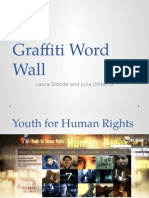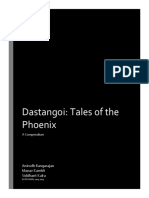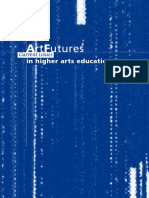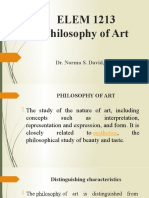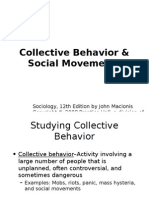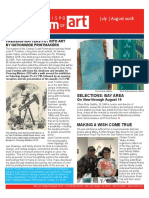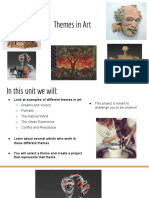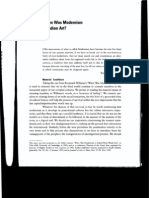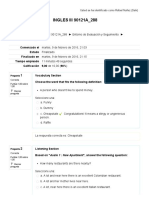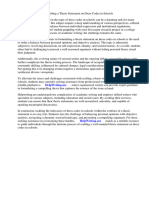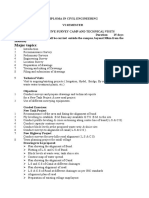Art Education in Action On The Street
Art Education in Action On The Street
Uploaded by
Meg J BishCopyright:
Available Formats
Art Education in Action On The Street
Art Education in Action On The Street
Uploaded by
Meg J BishOriginal Title
Copyright
Available Formats
Share this document
Did you find this document useful?
Is this content inappropriate?
Copyright:
Available Formats
Art Education in Action On The Street
Art Education in Action On The Street
Uploaded by
Meg J BishCopyright:
Available Formats
Art Education in Action
SHENG KUAN C H U N G A N D CHRISTY ORTIZ
S
above Figure 1. Artists working individually and coUaboratively on their assigned squares.
howcasing the many forms and functions of art helps to articulate the fundamental importance of art education, whether it is to enhance the child or to support society. In many U.S. public schools, art education remains peripheral, and even in schools where it is offered, it is unlikely to get a fair share of program budget allocations. Increased public visibility and recognition is therefore vital for the continued survival of art education in the public school system; however, it is notable that advocacy for art education is usually carried out in an institutional venue such as classrooms, publications, or conferences targeting educational professionals, and not the general public.
46
ART EDUCATION / May 2011
In illuminating the importance of art education, educators can eloquently argue about its value and contributions through an institutional tunnel, or they can take art education literally out to the street to benefit people in the community and educate the students involved. Partnerships with local community organizations is essential if art education is to become part of a greater societal change, increase its social recognition, and promote its unique creative role in public schooling. As Ulbricht (2002a) points out, "To gain the support of community members, art educators need to present art education in terms that ordinary citizens can appreciate. Teachers need to show the public how art education benefits everyone in the community" (p. 8). This article emphasizes the connection between classroom learning and community involvement and describes how we engaged art methods students as artist participants in Via Colori', a street painting fundraising event. Through our work in the University of Houston's Art Education Program, we maintain that getting students, including K-12 levels, involved in community art events increases both the visibility and perceived value of art education in the public domain and possibly social recognition for art education, because it showcases practical contributions of art to the community. Community involvement serves as a catalyst for art educators to engage students in projects of possibility beyond the school walls, projects that offer them such a "real-world" learning opportunity as working directly and coUaboratively with members of the community to solve community problems. Tliese experiences can forge a sense of community while experiencing firsthand how art can really change people's lives.
students to study art and artists in local communities to gain personal insights into how art builds community capital. Further, Ulbricht (2005) defines various types of community-based art education such as outreach programs, service learning, public art sites, and ethnographic inquiry. And Bastos (2002) maintains that the value of community-based art education that is based on "encompassing a variety of art frameworks challenges narrowly defined categorizations, inspiring participatory visions of art and society" (p. 71). Connecting classroom learning with community activities instills a sense of social awareness in students of any level, planting the seed for their active involvement within their own communities in the future. In art education, such links not only allow students to experience art as a form of cultural participation in real-world situations (i.e., those that involve interaction with members of the community), but also encourage art educators to utilize relevant resources as part of their authentic curriculum. Community involvement pushes school participants out of their institutionally confined comfort zone into interacting with the public to carry out a collaborative effort for greater social transformation. Creating art in the public arena to benefit the community is regarded as participatory public art, as it contributes both to community life and to the service of the public realm. Nikitin (2000) asserts that participatory public art projects are most effective when they are part of a multidisciplinary approach to revitalizing a city downtown or neighborhood and are produced in collaboration with the people in the community. Participating in community events, such as a Via Colori street painting festival, allows art educators and students to form relationships with the public and create a network of community support for art education, as echoed by Ulbricht (2002a): "If the discipline and practice of art education is to survive and expand, we must improve our advocacy efforts and make connections to the greater community" (p. 7).
About Via Colori'
Every year, students at the university where we work participate in Via Colori as a class assignment for an art methods course. Via Colori is a street painting festival hosted by nonprofit organizations across the country.' It unites artists, volunteers, and business sponsors from a local community to raise funds for helping people in need. Street painting, according to the Via Colori website,-' originated in the public art of the 16th century, when traveling artists would decorate the courtyards of Italian cathedrals with religious icons to solicit money. In America, a modernized version of street painting began in the mid 1980s. Since its inception in 1994, Via Colori has become the largest festival of its kind to be licensed in numerous cities. Each year its founder adds only one city to the list, thereby controlling its growth.' The uniqueness of the street art festival lies in its celebration of artistic expression and spirit of sharing and collaboration. The festival provides local artists with a public space where they can express their creativity to help support a charitable cause. Every individual work of art, which the artist draws right on the pavement of streets blocked off for the purpose, has a sponsoreither a business entity or an individual philanthropist. Street painting events such as Via Colori and others take place in urban cities throughout the country. We contacted the beneficiary host of Via Colori in Houston, Texas, The Center of Hearing and Speech (CHS), to learn more about the event and expressed our interest in getting college student artists involved. The CHS, a nonprofit organization classified as a United Way agency, has organized Via Colori as a fundraising event since 2006. The CHS offers many services to local children with hearing and speech impairments, mostly from families living below the poverty hne. It is the only full-service, education-based facility in Houston that provides audiology, speech-language pathology education, and family support services. Because the CHS relies heavily on the community's support to function, the income brought in from donations and fundraising events such as Via Colori are critical to maintaining its many services and its basic day-to-day operations.
Art Education in Communities
Tlie word "community" in this article refers to "the local environment that exists outside classroom walls" (March, 1998, p. 7). Over the years, art education has taken part in varied forms of community learning and engagement. London (1994) encourages his students to utilize their school and surrounding neighborhood as a resource site for materials, issues, and motivations for art creation. Ulbricht (2002b) guides his
May 2011 /ART EDUCATION
47
Because many of the participating artists from previous years have returned, the scope of the event has steadily expanded. Members of the public usually find out about the festival through the center s website and sign up online as artists or sponsors if they are interested. The event also includes an area for young children to create their street pieces. The CHS promotes the event through different communication outlets such as local television stations and newspapers, employees of business sponsors who spread the word, as well as flyers and postcards. In addition to promotions, days prior to the event, the CHS holds an orientation for artists who are unfamiliar with pastels and techniques for painting on the street pavement. Through the street art festival, the CHS facilitates a social networking opportunity for local artists to connect with one another and to meet with the public, a dynamic scene rarely seen in a conventional art viewing setting. To prepare for the event, we asked art methods students to sketch out their ideas in the classroom so they would be ready to paint during the festival. A class critique was held to help students refine their ideas. In addition, they were asked to write down a description of their painting to articulate what they wanted to convey to the public through their work, as well as reflecting on this particular experience.
The Viewers were an essential part of the creative landscape at the festival. The festival offered them a more direct and intimate art viewing experience, as some viewers would ask the artists questions about their work.
Site Observations
We were curious about the connection between Via Colori and the CHS. According to CHS development director Natahe Vuckovic, the CHS was looking for more unusual and exciting ways to raise funds, ones that would work well in the city and give the center much-needed exposure. The CHS thought that through celebrating art and creativity, the street art festival would be an event that would grab people's attention and that everyone could enjoy. In 2007, CHS planned to organize an annual street art festival, raising funds for and awareness of the center and expanding public involvement (personal communication, September, 14, 2007). The CHS has continued this plan, and since then organized the street art festival for 2008 and 2009. To solicit artist participants, the CHS approaches art students on college campuses and local arts organizations, as well as inviting artists to spread the word. We observed the 2-day festival take place at a city park in Fall 2007 and 2008. On the first day of the event, many artists arrived early to review guidelines. Volunteers were available to help the artists gather materials and direct them to their assigned squares on the street (see Figures 1 and 2). Different-sized squares were laid out on the street concrete, ranging from 4 to 10 feet. Two city roads were blocked ofli', allowing the festival layout to include a music performing stage, a karaoke area, and multiple food stands. Several of the artists who chose to work on the larger squares were collaborating with someone else on their art. Throughout the day, family and friends gathered around the artists to support them while they created their art piece. Although the artist participants were working closely with each other, they still had adequate walking space to move around and view one another's work. We observed college students mingling with professional artists from the community
48
ART EDUCATION /May 2011
far left Figure 2. The beginning of the festival as artists sketch out their work. above Figure 3. An artist participant executing realistic painting techniques on the street. right Figure 4. Viewers are an essential part of the art creation during the event.
and immersing themselves in making art in a non-competitive atmosphere. The same phenomenon also occurred in the children's section where younger artists eagerly talked with one another about their creations. When the artists took breaks, they also seized the opportunity to converse with each other to share artistic techniques and ideas. This type of meandering opened up many learning opportunities for students and professional artists about diflerent ways of executing creative ideas (see Figure 3). While the artists were working, the viewers would walk around them looking at their creations, chat with them, make short positive comments (e.g., "That's cool," or "reafly interesting"), and take pictures of the artworks. Tlie viewers were an essential part of the creative landscape at the festival (see Figure 4). The festival offered them a more direct and intimate art viewing experience, as some viewers would ask the artists questions about their work. It was
reasonable to assume that most of the viewers were less familiar with street painting and had probably rarely seen artmaking in progress in an outdoor setting. At the festival, like many viewers, we were continually amazed by the music performances and the range of painting styles displayed on the pavement, from realistic and impressionistic, abstract and propagandistic, to reproduced and decorative work (see Figures 5 and 6). A student artist who observed the event later made the point: I think that for young people it is sometimes hard to visualize themselves as "artists," but when you see these regular people from all walks of life, and all ages, then it gives them a better understanding of the broad spectrum of who an artist can be. (Personal communication, December 2, 2008)
The completed student artworks depicted highly expressive renderings and compositions. Many included recognizable images, such as the earth, flowers, women, and animals, and combinations of text with images in a variety of styles. Whereas many artists worked in an isolated studio or belonged to certain art groups and organizations, the street art festival brought together a creative force of hundreds of local artists and their families and friends, as well as the general public, for an artistic celebration that helped support people in need. This event broadened people's perceptions of art since the artworks were temporary, event-specific, and required audience participation. A few weeks after the festival, the CHS mailed participating artists a photograph of their artwork in appreciation o^ their contribution. Since f the event, many artists have kept in contact with the center, sending art opening invitations to members in the center's network.
May 2011 /ART EDUCATION
49
This community involvement may have a lasting impact on students in forging a sense of community awareness and social consciousness.
Reflections
We asked several student participants in the 2007 and 2008 festivals to reflect on this community involvement. Prior to the event, a couple of students had been concerned about their lack of experience in using chalk on pavement and apprehensive over exposing their artwork in progress to the public. Unlike conventional art exhibits, visitors to the street festival are able to view the process of artmaking, rather than seeing only the finished product. Nevertheless, most indicated their confidence with this type of public exposure, as voiced by one student: There was sonnething about making public art for anyone to enjoy that made me feel very energetic. I saw a lot of talented artists on the streets. I
really enjoyed when people stopped and took the time to take a picture of my piece. The students commented on learning from this community involvement as art education students. They stressed the importance of art sharing and interacting with other artists to acquire new painting techniques. One studetit noted the collaborative atmosphere fostered by the event: "I saw a lot of social interaction between students taking place and engaging in decision-making processes." Another felt that by taking part in the event, she would be able to demonstrate firsthand knowledge to her future students and stated, "I feel that the more a teacher does this, they experience what the students feel like when they show their work in contests, gallery shows, and even just to their peers." For one in-service
50
ART EDUCATION / May 2011
Figure 5. An artist participant immersing herself in her work. above Figure 5. A student artist placing the final touches upon her art.
teacher, it was important for her schoolchildren to know that their art teacher was actively involved with activities related to what they were being taught in class. She said, "The children will see an example of how their art teacher is doing art outside of the classroom to help the community." The students witnessed the street painting festival bringing a community together to help children with hearing and speech impairments. One acclaimed, "I was really impressed with the various companies that sponsored this charity event and [it] made me realize which businesses support the arts as well as charity." Another echoed, "I felt great knowing that everything was for a good cause. It was wonderful seeing so many artists hitting the streets with chalk and brushes." This community involvement may have a lasting impact on students in
forging a sense of community awareness and social consciousness. One student revealed. After I finished and I walked around I was overcome with a feeling of pride that I had been connected with this and that It was benefiting a truly deserving cause. I really believe that this experience has opened up a need in me to be more involved in community art projects. The students also responded to the significance of this participation for the field of art education. Many thought that this experience could act as a reminder for art educators to provide their students with relevant collaborative projects, opportunities for artistic expression, positive reinforcement, and use of one's
community as a resource for real-world experiences. One student stated: As teachers we should provide lessons that are collaborative so that students learn to work together toward a common goal. I really enjoyed the experience of a spectator saying something positive about the message in my artwork. As an educator I will remember to provide positive comments to my students. One student noted the cycle of beneficiaries that results from this type of meaningful event. He said, "Businesses gain recognition, charities gain needed money, artists gain a creative outlet for ideas and expression, and the community builds its culture and enrichment."
May 2011/ART EDUCATION
51
Another found that bringing arts into the public arena could also make a lasting impact on the community: "Besides raising money, it brings people together and strengthens the message. I believe students need to participate in these types of events in order to see the impact their art can have in their community." Although Via Colori is only available in certain cities, educators may find similar opportunities in their own communities for students to get involved. A good place to begin is to check out local newspapers and community magazines that list art events on a weekly basis. Additionally, in many parts of the country, there are local art festivals featuring artmaking activities for both young children and adults. Tliese are community involvement opportunities in which educators can engage their students.
partners in the creative process, participatory public art strives to break away from the conventional roles assigned to artists and viewers" (p. 44). Indeed, street painting events engage viewers and student artists alike in redefining art as a participatory, collaborative, and transitory event created with and for the people in the community. Although the main objective of the Houston festival is to raise funds for and social awareness of the CHS, it should be noted that art makes this community gathering possible and memorable. The art festival brings citizens of a community together to take part in the creative process for greater social transformation, and art education students are part of this dynamic collective force. Through participating in a community art event such as Via Colori, art education students are able to contribute to the community in a concrete manner and demonstrate to the public the real-world implications of art, which in return strengthens their personal and professional efficacy as prospective teachers and artists. By providing learning experiences beyond the classroom walls, both students and educators have an opportunity to venture outside their comfort zones and to engage in
projects of possibility. The experience of putting art education in action on the street benefits both people in the community and the students in the classroom. A student participant concluded: Being able to create this piece in front of and with others allowed for a very vivid type of immediate feedback. The experience of creating public art not only deepened my understanding of artmaking, which is Important for an
arts educator; it allowed me to better
understand the benefits of engaging students in community arts events, when there are opportunities. (Personal communication, December 2, 2008) Sheng Kuan Chung is Associate Professor and Graduate Program Director in the Department of Curriculum and Instruction at the University of Houston. E-mail: skchung@uh.edu Christy Ortiz is Instructor at Savannah College of Art and Design, Savannah, Ceorgia. E-mail: Cortiz@scad.edu
Conclusion
The street painting event can be seen as a form of participatory public art created with and for members of the community. Tlie viewers are an essential part of the overall art creative process af the fesfival. As Stephens (2006) describes parficipafory public art: "By welcoming community members as active
REFERENCES Bastos, F. M, C. (2002). Making the familiar strange: A communitybased art education framework. In Y. Gaudelius & P. Speirs (Eds.), Contemporary issues in art education (pp. 70-83). Upper Saddle River, NJ: Prentice Hall. London, P. (1994). Step outside: Community-based art education. Portsmouth, NH: Heinemann. March, T. (1998). Looking outward, looking in: Community in art education. Art Education, 57(3), 6-13. Nikitin, C. A. (2000). Making public art work. Sculpture, 9(3), 44-49. Stephens, P. G. (2006). A real community bridge: Informing community-based learning through a model of participatory public art. Art Education, 59(2), 40-46. Ulbricht, I. (2002a). Polishing the image of art education in the community. Art Education, 55(1), 6-10. Ulbricht, J. (2002b). Learning about community art behaviors. Art Education, 55(5), 33-38. Ulbricht, J. (2005). What is communitybased art education? Art Education, 5S(2),6-12.
ENDNOTES
^ Teachers can find other similar public art events in their local communities. 2 To find out more about Via Colori, go to www. viacolori.com ^ To host Via Colori, a nonprofit entity pays a licensing fee and a minimal royalty of 3% of the revenues generated from the event; 97% of the revenues go to the nonprofit entity to further its mission.
52
ART EDUCATION / iVlay 2011
Copyright of Art Education is the property of National Art Education Association and its content may not be copied or emailed to multiple sites or posted to a listserv without the copyright holder's express written permission. However, users may print, download, or email articles for individual use.
You might also like
- Joram Mariga and Stone SculptureDocument6 pagesJoram Mariga and Stone SculpturePeter Tapiwa TichagwaNo ratings yet
- Video Installation Art: The Body, The Image, and The Space-in-BetweenDocument14 pagesVideo Installation Art: The Body, The Image, and The Space-in-BetweenAnonymous qBWLnoqBNo ratings yet
- Curriculum: Contemporary Art Goes to SchoolFrom EverandCurriculum: Contemporary Art Goes to SchoolJennie GuyNo ratings yet
- All-in-One OET Reading Part A Guide With Practice Test & TipsDocument34 pagesAll-in-One OET Reading Part A Guide With Practice Test & TipsChinonso Nelse Nwade0% (1)
- Community-Based Art Ed in A Changing LandscapeDocument12 pagesCommunity-Based Art Ed in A Changing Landscapeapi-285117323No ratings yet
- Foundations of EducationDocument24 pagesFoundations of EducationMubeen Hacker Mubeen HackerNo ratings yet
- Enlightening The Archaic Elegance of Haveli Naunihal SinghDocument79 pagesEnlightening The Archaic Elegance of Haveli Naunihal Singhtoobarashid248100% (1)
- Compare The Quality of Education Between Public and Private SchoolsDocument7 pagesCompare The Quality of Education Between Public and Private SchoolsAnonymous BI242GmNo ratings yet
- Graffiti Word WallDocument8 pagesGraffiti Word Wallapi-273357765No ratings yet
- Dastangoi Tales of The PhoenixDocument100 pagesDastangoi Tales of The PhoenixAltaf MalikNo ratings yet
- Fashion Cycle - Steps of Fashion CyclesDocument3 pagesFashion Cycle - Steps of Fashion CyclesSubrata Mahapatra100% (1)
- Artfutures: in Higher Arts EducationDocument108 pagesArtfutures: in Higher Arts EducationSantosh ThoratNo ratings yet
- Aloe Vera Apparels For Fit, and Youthful LifeDocument2 pagesAloe Vera Apparels For Fit, and Youthful LifeJakariya NugrahaNo ratings yet
- Philosophy of ArtDocument22 pagesPhilosophy of ArtHomer PunzalanNo ratings yet
- Pakistan Film Industry RevivalDocument23 pagesPakistan Film Industry RevivalAgha WaseemNo ratings yet
- Balochi DressDocument3 pagesBalochi DressRida KhanNo ratings yet
- Chapter23 Collective Behavior & Social MovementsDocument35 pagesChapter23 Collective Behavior & Social MovementsMajendra Nikki HanggoroNo ratings yet
- Installation Art For Smartphone Addiction Campaign (Journal)Document4 pagesInstallation Art For Smartphone Addiction Campaign (Journal)Anthony FookNo ratings yet
- 3rd International Conference For Design EducationResearchersDocument407 pages3rd International Conference For Design EducationResearchersJoffre LoorNo ratings yet
- Curation: BY: Anne Marie Eugenie L. Pugoy Beed 1-BDocument14 pagesCuration: BY: Anne Marie Eugenie L. Pugoy Beed 1-BANGEL GABRIEL. COLLANTESNo ratings yet
- Contemporary Visual Art - in The Sharjah Arts MuseumDocument2 pagesContemporary Visual Art - in The Sharjah Arts MuseumAbdulraheemNo ratings yet
- Arts and Social Change Backgrounder April 2018Document5 pagesArts and Social Change Backgrounder April 2018Ralitsa100% (1)
- Contemporary Art and Art EducationDocument11 pagesContemporary Art and Art Educationchen danyiNo ratings yet
- Women Art and Power by Yolanda Lopéz and Eva BonastreDocument5 pagesWomen Art and Power by Yolanda Lopéz and Eva BonastreResearch conference on virtual worlds – Learning with simulationsNo ratings yet
- Geertz, Clifford (1973) - Thick DescriptionDocument17 pagesGeertz, Clifford (1973) - Thick DescriptionAlmendra Espinoza-Rivera100% (1)
- Mind in MatterDocument20 pagesMind in MatterFernanda_Pitta_5021No ratings yet
- TransavantgardeDocument193 pagesTransavantgardeanushka pandiyaNo ratings yet
- Kate Ross Curator - PortfolioDocument7 pagesKate Ross Curator - PortfoliokaterosscuratorNo ratings yet
- El Anatsui October GalleryDocument35 pagesEl Anatsui October GalleryJaimey Hamilton FarisNo ratings yet
- Session 1-Curating For Art Exhibit and Writing For The ArtsDocument29 pagesSession 1-Curating For Art Exhibit and Writing For The ArtsCrisencio M. PanerNo ratings yet
- Frames ConcFramewk Artmaking 1Document10 pagesFrames ConcFramewk Artmaking 1JDevotee100% (1)
- Art Appreciation: Prepared By: Ms. Edielyn D. GonzalvoDocument67 pagesArt Appreciation: Prepared By: Ms. Edielyn D. GonzalvoEdielyn GonzalvoNo ratings yet
- ArtNews July August 2018Document6 pagesArtNews July August 2018SLOMuseumofArt100% (1)
- Pisaot - Experimental Arts Residency Program (English) PDFDocument3 pagesPisaot - Experimental Arts Residency Program (English) PDFsangsalapakNo ratings yet
- Themes in ArtDocument30 pagesThemes in Artapi-596100675No ratings yet
- Art: Form & IdeaDocument54 pagesArt: Form & IdeaJackeline ChaparroNo ratings yet
- Lugbara MythologyDocument2 pagesLugbara Mythologyapurimemuka100% (2)
- Art and Society Art StudDocument5 pagesArt and Society Art Studkristiaa_1No ratings yet
- DandyDocument5 pagesDandynsimiNo ratings yet
- Arts and Crafts Movement: HistoryDocument12 pagesArts and Crafts Movement: HistoryValentina Ramona PaulNo ratings yet
- Lesson 24 - Converging Histories - The Global Art WorldDocument80 pagesLesson 24 - Converging Histories - The Global Art Worldpristine de guzmanNo ratings yet
- Fine Art: Characteristics and Expressive Feature in ArtDocument8 pagesFine Art: Characteristics and Expressive Feature in Artgenalyn llanesNo ratings yet
- The Role of Art in SocietyDocument1 pageThe Role of Art in Societymandykins26No ratings yet
- Art Design AestheticsDocument27 pagesArt Design AestheticsTiasa PalNo ratings yet
- Modernism: Introduction To British Arts and CraftsDocument21 pagesModernism: Introduction To British Arts and CraftsDebashree MishraNo ratings yet
- Richard Bartholomew The Art CriticDocument8 pagesRichard Bartholomew The Art CriticAkash Glory0% (1)
- Aesthetics. Popular Visual Culture and Designer CapitalismDocument12 pagesAesthetics. Popular Visual Culture and Designer CapitalismPaula Amador CardonaNo ratings yet
- Managing Creativity and Arts in SEADocument125 pagesManaging Creativity and Arts in SEADoãn Phương LinhNo ratings yet
- Art in Context PDFDocument372 pagesArt in Context PDFHugo Leautaud SNo ratings yet
- Jitish KallatDocument50 pagesJitish Kallatadarsh raoNo ratings yet
- Meaning of Art EducationDocument10 pagesMeaning of Art EducationAdelekan FortuneNo ratings yet
- AnthropologicalApproaches 032513compDocument12 pagesAnthropologicalApproaches 032513compJames LindonNo ratings yet
- Global Reception - Indian ArtDocument37 pagesGlobal Reception - Indian ArtruilopesNo ratings yet
- Indian ModernismDocument6 pagesIndian ModernismRinaNo ratings yet
- On Ethnographic Authority (James Clifford)Document30 pagesOn Ethnographic Authority (James Clifford)Lid IaNo ratings yet
- The Lagos Art Market by Samuel P. ChukwukaDocument13 pagesThe Lagos Art Market by Samuel P. ChukwukaPrince Chukwuka SamuelNo ratings yet
- Kapur Geeta When Was ModernismDocument27 pagesKapur Geeta When Was Modernismphilosophie8100% (1)
- The Transformation of Aesthetics in Architecture From Traditional To Modern Architecture: A Case Study of The Yoruba (Southwestern) Region of NigeriaDocument10 pagesThe Transformation of Aesthetics in Architecture From Traditional To Modern Architecture: A Case Study of The Yoruba (Southwestern) Region of NigeriaJournal of Contemporary Urban AffairsNo ratings yet
- Arts Transformation Final Course SyllabusDocument6 pagesArts Transformation Final Course SyllabusAli ColleenNo ratings yet
- A Creative Legacy/ A History of The National Endowment For The Arts Visual Artists' Fellowship ProgramDocument264 pagesA Creative Legacy/ A History of The National Endowment For The Arts Visual Artists' Fellowship Programhandika saputraNo ratings yet
- Still Life: Ecologies of the Modern Imagination at the Art MuseumFrom EverandStill Life: Ecologies of the Modern Imagination at the Art MuseumNo ratings yet
- Stolen Cars Repository: Software Requirements SpecificationDocument11 pagesStolen Cars Repository: Software Requirements Specificationmazampkn2No ratings yet
- Arithmetic and Geometric Means PDFDocument4 pagesArithmetic and Geometric Means PDFBodz 2214No ratings yet
- Major Roles Included:: Ms. Zaria Sebbi's ResumeDocument6 pagesMajor Roles Included:: Ms. Zaria Sebbi's ResumeHSFXHFHXNo ratings yet
- 15mins Test 1 B1 LEVELDocument2 pages15mins Test 1 B1 LEVELWendyNo ratings yet
- Bba BPM Sem-V, Vi 2018 CourseDocument7 pagesBba BPM Sem-V, Vi 2018 CourseJagmeet SinghNo ratings yet
- Physics MS RoadmapDocument2 pagesPhysics MS RoadmapAhmedAdelNo ratings yet
- Chapter 5 Integrative ApproachesDocument41 pagesChapter 5 Integrative ApproachesXavier AguirreNo ratings yet
- My Classroom Management Plan Villar PostradoDocument6 pagesMy Classroom Management Plan Villar PostradoNyca PacisNo ratings yet
- GR 8 Term 2 2018 Ns Lesson PlanDocument182 pagesGR 8 Term 2 2018 Ns Lesson Planndodana SibandaNo ratings yet
- Actividad 2 Ingles III 9 de 10Document6 pagesActividad 2 Ingles III 9 de 10Rafael Núñez Hernández100% (1)
- BLDPA-Journal - 22 03 2017Document68 pagesBLDPA-Journal - 22 03 2017AppSecurityNo ratings yet
- Task 1: The Chart Below Shows Changes in The Number of International Students in AustraliaDocument2 pagesTask 1: The Chart Below Shows Changes in The Number of International Students in AustraliaHải Võ ĐìnhNo ratings yet
- Lesson 2 Acrostic PoemsDocument7 pagesLesson 2 Acrostic Poemsapi-302459286100% (1)
- Gnokou (2013) The Sociolinguistic Paramters of L2 Speaking AnxietyDocument18 pagesGnokou (2013) The Sociolinguistic Paramters of L2 Speaking AnxietyDwain DoctanaNo ratings yet
- Writing and GrammarDocument72 pagesWriting and GrammarErica Lee100% (1)
- Thesis Statement Dress Codes SchoolsDocument5 pagesThesis Statement Dress Codes SchoolsCustomizedWritingPaperNewark100% (2)
- TN BooksDocument2 pagesTN BookssaranNo ratings yet
- Reaction PaperDocument2 pagesReaction PaperjennyNo ratings yet
- Psychosis-SchizophreniaDocument14 pagesPsychosis-SchizophreniaCabdiladif Ahmed McrfNo ratings yet
- Investiture Script - Senior Scouting SectionDocument9 pagesInvestiture Script - Senior Scouting SectionwbezuryontnNo ratings yet
- David Thai AnalysisDocument3 pagesDavid Thai AnalysisBảo GiaNo ratings yet
- Senthi Kumar. CVDocument3 pagesSenthi Kumar. CVAmresh PradhanNo ratings yet
- Rili DLP MutationDocument16 pagesRili DLP MutationJohn Bernard RiliNo ratings yet
- Murder in The ClassroomDocument3 pagesMurder in The ClassroomGrace ChenNo ratings yet
- Culture ShockDocument2 pagesCulture ShocknotmanhlinhNo ratings yet
- UNIT-III (Gropu Discussion) (MBA-4 (HR)Document6 pagesUNIT-III (Gropu Discussion) (MBA-4 (HR)harpominderNo ratings yet
- Bcu g87 Magc 205 Finals Lesson HDocument4 pagesBcu g87 Magc 205 Finals Lesson HJoan BayanganNo ratings yet
- modMODULE II-D MUSCARINIC CHOLINORECEPTOR ANTAGONISTSDocument6 pagesmodMODULE II-D MUSCARINIC CHOLINORECEPTOR ANTAGONISTSKenneth NuñezNo ratings yet
- Extensive Survey ProjectDocument2 pagesExtensive Survey ProjectShaik Jhoir45% (11)








